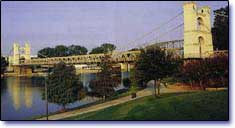

Places in Time
The ALICO Building: A Long, Tall Texan
More facts about the ALICO building
By: John Young, Waco Tribune-Herald
When Artemas Roberts founded the Amicable life Insurance Co. in 1910, he wanted a building that would stand the test of time. He got more than he bargained for.
There it stands at Fifth and Austin, the reference point for Waco, austere yet bold. It was Texas' first skyscraper and the state's tallest building for a time. It reigned over Waco's business district when the downtown was the core of civic fusion. There it stood stoically, with but a few shattered windows, after a tornado gouged out the heart of the downtown district.
When the building was completed in 1911, it was hailed as the symbol of Waco's future, just as the Suspension Bridge over the Brazos was a symbol of its past. Though in its 75th year, the ALICO building remains a symbol of the future in many ways.
Why did Waco get Texas' first skyscraper? Because Roberts projected Waco as a commercial giant. Maybe he wanted his skyscraper to be the first on the block.
"I think Roberts saw Waco was a very progressive community, successful in the cotton industry, with a lot of influential people he could attract as investors and policyholders," said Thomas Westbrook Jr., senior vice president of American-Amicable Life Insurance.
Having been chosen as the site of Texas' first skyscraper thrilled the city, as if it had been anointed with a new destiny, and the building became Waco's focal point.
At first it was to have had 20 floors, but when Roberts found out the Adolphus Hotel in Dallas also would have 20 floors, he upped it by one. The builder of the Adolphus also decided to go up to 21, and so Roberts added a 22nd floor, making the ALICO building the tallest one south of the Mason-Dixon Line for a few years.
However, the two most important stories in the building were not those on its top but those at its bottom. Contractors Sanguinet & Staats sought to construct as indestructible building, and did so by digging 40 feet into the ground, down to solid rock, to begin laying the foundation. Then with the use of massive steel H-beams the building sprang up, boldly proclaimed as sturdy enough to sustain a "hurricane load."
Then on May 11, 1953, a bully came knocking on ALICO's door.
At 4:36 p.m. a tornado made a direct hit on downtown Waco, so intense and massive no one downtown could detect its shape as it crashed into the city. Arriving from the south, it seemed to head right for the ALICO building and then veer west, as if body-checked by the tall and mighty structure.
As it struck, the building swayed and employees at the top floors were thrown against the walls. Westbrook was there. He remembers one employee had a hand braced against a wall and felt a crack open up between his fingers.
The damage to the building was largely superficial, however, whereas other buildings collapsed for almost a mile over a two-block stretch, including the five-story R. T. Dennis building across Austin Avenue from ALICO.
"It was almost like the tornado had hit our building, bounced off and went another direction," said Westbrook.
In the wake of the tornado, which claimed 114 lives while destroying 150 homes and 196 businesses, the ALICO tower became Waco's crisis center. Having been built with its own generator, it was the only structure in downtown with electricity. From the First National Bank on the ground floor, medical and military officials coordinated search parties and rescue efforts. They spent the next 48 hours there working around the clock.
Like the building itself, the 1953 tornado has become a reference point for downtown Waco, which in many ways is still shaking off the storm's lingering effects as it seeks to restore its vitality.
In 1982 the ALICO tower won its badge of honor when the Texas State Historical Commission designated it a historical landmark.
Meanwhile, changes took place in the company founded long ago by Aretemas Roberts. Amicable Life merged with American Life Insurance of Dallas in 1965 and the company became known as American-Amicable. Gulf Life Holding Co. of Florida purchased American-Amicable in 1968. American General Corp bought the company in January of last year.
The American General operations are to be consolidated in Houston in the next three years. American-Amicable will retain a presence in Waco, but much of the office space now used almost completely by the insurance company, will be leased out. When that time comes, one would think American General will have little trouble finding tenants. The building remains impressive and function as ever. And -- what a view.
Westbrook, who has worked for Amicable since 1947, said its founder built the tower "as a symbol of strength and stability."
Strength? I'll say.
-- January 10, 1985